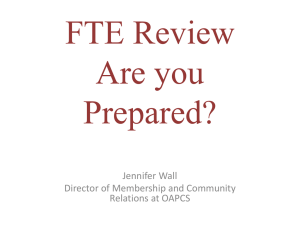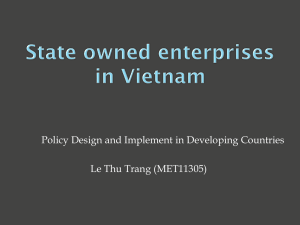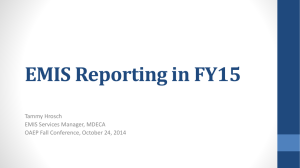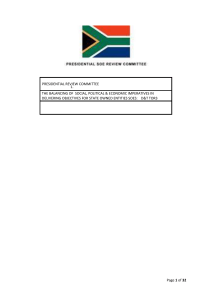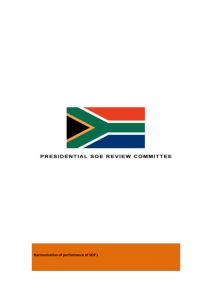Corporate Governance at SOEs
advertisement
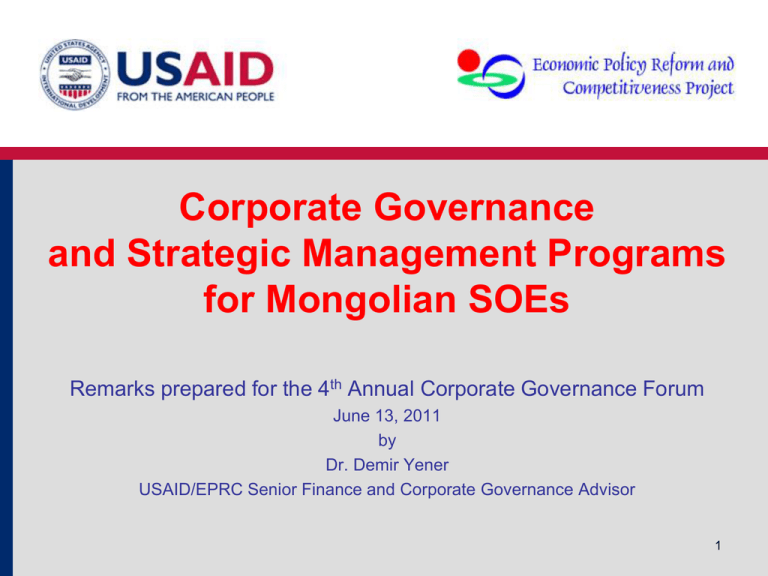
Corporate Governance and Strategic Management Programs for Mongolian SOEs Remarks prepared for the 4th Annual Corporate Governance Forum June 13, 2011 by Dr. Demir Yener USAID/EPRC Senior Finance and Corporate Governance Advisor 1 Agenda • Review the OECD Principles of Corporate Governance • Design of CGRI for Mongolian SOEs • Best practices in implementing Corporate Governance at SOEs and recommendations for reform • Design, development and implementation of Balanced Scorecard strategic management tool for 3 pilot SOEs • International Examples on CG reforms, specifically the Khazanah Nasional Experience in Malaysia • Conclusive remarks on lessons learned EPRC SPC Joint Program • In April 2010, EPRC responded to a joint request by SPC, the Ministry of Finance and the Ministry of Mining and Mineral Resources to design and develop a program to assist the GoM in improving CG at 73 SOEs. • Developed a Balanced Scorecard program, which was delivered to 3 pilot companies. • Developed and administered a CGRI. • Reviewed and commented on SOE corporate documentation • Developed a – DRAFT CG Code for Mongolian SOEs based on the OECD guidelines. – DRAFT CG Regulations for SOEs to be implemented by SPC OECD CG Guidelines for SOEs (2005) 1. Ensure a level playing field in markets where state owned enterprises and private firms compete 2. The state should be an informed and active owner and establish a clear and consistent ownership policy 3. The state and SOEs should recognize the rights of all shareholders 4. The state policy should recognize the SOEs responsibilities to all stakeholders 5. SOEs should observe high standards of transparency 6. The SOE boards should have the necessary authority competence and objectivity to carry out strategic guidance and monitoring of management 4 Introduction to Corporate Governance World Bank Mongolia ROSC CG Assessment (2009) # Category Assessment I. Effective CG Framework Partially Implemented II. Shareholders rights and key ownership functions Partially Implemented III. Equitable Treatment of Shareholders Broadly Implemented IV. Role of Stakeholders in Corporate Governance Partially Implemented V. Disclosure and Transparency Partially Implemented VI. Responsibilities of the Board Partially Implemented OECD Principles Essential Criteria Applied on ROSC Assessment Criteria Explanation Fully implemented Most of the OECD Principles essential criteria are met Broadly implemented One or more of essential criteria are less than fully implemented Partially implemented Part of the essential criteria are met Not implemented Assessment is likely where major shortcoming exist Not applicable Range (%) 95 % > 75 – 94.5 % 35 – 75.9 % < 35 % Assessment is only applicable where an OECD principle does not apply due to structural legal or institutional features. n/a OBSERVATIONS REGARDING SOE’S Key Elements in SOE governance OECD Guidelines on Corporate Governance of SOEs 1. State governance of SOEs – Effective Legal and Regulatory Framework for SOEs – State Acting as an Owner 2. Corporate governance of SOEs – Key concepts– separation of responsibilities • Governance-- by the board of directors • Executive Management-- of day-to-day company affairs Global Best Practice Objectives of SOEs • To be at least as profitable and efficient as comparable private sector enterprises • To use progressive employment practices • To be socially responsible corporate citizens • To create sustainable value for the society Legal and Regulatory Frameworks on State Ownership • Law on Management and Financing of Budgetary Institutions (LMFBI) • Law on State and Local Property (LSLP) • Decree of State Property Committee • Department of State Property Management and Privatization • Department of Monitoring, Registration, and Procurement Mongolian Laws and Regulations OECD Guidelines on CG of State-owned Enterprises Law on Management and Financing of Budgetary Institutions: Article 22.1 “Minister of Finance controls finances of SOEs and SPC controls work performance” Chapter 1.B: effective Legal and Regulatory Environment “Government should strive to simplify and streamline the operations practices and the legal form under which SOEs operate” Law on Management and Financing of Budgetary Institutions: Article: Article 30.1 The CEO to list all procurements expenses and supplier Chapter 2. B: State as an Owner The government should not be involved in the day-today management of SOEs and allow them full operational autonomy to achieve their defined objectives Law on State and Local Property (11.8) “SPC is to take off accounts assets, review requests for procurement and make procurement decisions” Chapter 2.C: State as an Owner The state should let SOE boards exercise their responsibilities and respect their independence. Law on State and Local Property (18.5) “SOE administrative posts and total staff numbers will be set by the SPC” Chapter 2. B: State as an Owner The government should not be involved in the day-today management of SOEs and allow them full operational autonomy to achieve their defined objectives Principles for Operations and Regulation of SOEs • Operational autonomy to implement policies established by their boards of directors • Competitive conditions comparable to private sector enterprises in non-monopoly sectors • The role of the Government in ownership of SOEs separate from Government regulation – SOEs shall not receive more favorable treatment than private sector enterprises Responsibilities of SPC re SOEs • SPC primary Government agency for oversight of SOEs – Voting shares of SOEs – Appointment or election of members of BoDs – Consultation with boards and ministries on annual performance targets – Monitoring implementation of performance targets Business Plans of SOEs • Targets with respect to: – Production of goods or services – Product development – Market development – Human resource development – Advancement in use of technology – Productivity – Composition of assets and liabilities – Profitability SPC SOE monitoring unit • Advise SPC on developing and implementing ownership policy with respect to: – Strategic direction of SOEs – Annual business plans and performance targets – Proposals to restructure particular SOEs – Need for management contracts for particular SOEs – Sale of shares in SOEs to other investors – Monitor performance of SOEs against targets – Performance of boards of directors of SOEs – Conduct inspections of SOEs Effective Legal and Regulatory Framework (OECD SOE CG Guidelines) • Governments should strive to simplify and streamline the operational practices and the legal form under which SOEs operate State Acting as an Owner (OECD CG Guidelines) • The government should not be involved in the day-to-day management of SOEs and allow them full operational autonomy to achieve their defined objectives • The state should let SOE boards exercise their responsibilities and respect their independence State Oversight of SOEs • Rules contain many inappropriate elements contrary to OECD Principles – – – – Top down, rigid approach Little room for exercise of discretion Suggests static versus dynamic business environment Diffuses accountability among SPC, SPC departments, BoD, GB, SB, COPA and ministries • Impression… – – – – Prevents expeditious actions Not reflect understanding of business motivations Discourages creative thinking Discourages constructive dissent State Governance of SOEs • Impression… – Discourages leadership – Discourages ambitious persons from SOEs • Leaders have to develop their plan, adjust plan, not simply implement plan determined by others • “Leaders run to problems, not away” • Excessive liability—direct and third party in SOE rules-discourages addressing problems RECOMMENDATIONS FOR IMPROVING CORPORATE GOVERNANCE OF MONGOLIAN SOES I: Ensuring an Effective Legal and Regulatory Framework for State-Owned Enterprises 1. Complete the corporatization process and harmonize SOEs’ legal status in the economy. 2. Clarify and ensure effective separation between the ownership function and regulation. 3. Make specific obligations and related costs transparent 4. SOEs ought not have preferential access to stateowned banks and private financial institutions 5. Promote public debate on the corporate governance of SOEs II: The State Acting as an Owner 1. Rationalize the state owned sector – which sectors will the government retain state ownership? 2. Develop and disclose an ownership policy, ensure accountability of ownership function 3. Ensure visibility, strength and consistency in the exercise of the ownership function 4. Avoid interference in SOE management 5. Develop structured and transparent board nomination process for SOE boards III: Equitable Treatment of Shareholders 1. Reinforce provisions protecting the rights of minority shareholders in relevant laws and regulations 2. Increase the independence of SOE boards and improve the transparency of their nomination process. 3. Reinforce minority shareholders’ capacity to obtain effective redress for the violation of their rights. 4. Support the development of minority shareholders associations IV: Relations with Stakeholders 1. Reassess and develop a strategic approach relative to stakeholder relations 2. Develop methods to allow and encourage stakeholders to exercise their voice. (Develop Alternate Dispute Resolution) 3. Encourage SOEs to report on stakeholder relations. V: Transparency and Disclosure 1. Clarify SOE objectives and make non-commercial ones explicit. 2. Use state budget to cover the costs of non-commercial objectives 3. Build up and publish relevant performance indicators. 4. Require large SOEs to be as transparent as listed companies. Disclose consolidated reports on state ownership 5. Actively monitor and benchmark SOE performance, ensure that SOEs are subject to a robust audit system VI: The Responsibilities of Boards of SOEs 1. Clarify and reinforce SOE board mandates and functions. 2. Ensure that SOE boards are actively engaged in shaping the strategy. 3. Require SOE boards to have nomination, remuneration and governance committees 4. Increase competencies of SOE boards by requiring certification training for SOE board members, including induction training 5. Develop performance evaluation for SOE boards Corporate Leadership and Strategic Management Programs for SOEs IMPROVING SOE PERFORMANCE 1- CORPORATE LEADERSHIP Corporate Governance Rating Index: What Gets Measured, Gets Done Development of Corporate Governance Rating Index: Different Services and Models Corporate First Report Coverage Governance Rating Issued In System The Corporate Library (TCL) 1750 (US) 2000 Intl Shareholder Services CGQ 7,500 (US & Intl) 2001 Governance Metrics International 1,625 (Intl) 2002 S&P Deutsche Bank Deminor Ratings Categories 7 Variables Undisclosed 8 61 7 600 Europe & US 1998 4 DJ EuroStoxx 50 2002 5 300+ () 1998 4 ~100 Undisclosed 300 Categories Used in Designing Mongolian CGRI Categories 1- Effective Legal and Regulatory Environment for CG 2- The State Acting as Owner: Shareholders 3- Equitable Treatment of All Shareholders 4- Stakeholders & Corporate Citizenship 5- Transparency and Disclosure 6- The Independence of Board of Directors Designing the CGRI for Mongolian SOEs The EPRC Project Team designed a CGRI that is a stand-alone index measuring the degree to which SOEs comply with the OECD Guidelines on Corporate Governance of State Owned Enterprises based on: 1. The OECD Principles of Corporate Governance; 2. Other international corporate governance standards and research; 3. Mongolian Company Law; 4. Mongolian “Code of Corporate Governance” (2007). Structure and Measurements of the SOE CGRI Category I.Effective Legal and Regulatory Framework II. The State acting as owner # of Questions 14 Percent Weighting 10 33 10 III. Equitable treatment of shareholders IV.Relations with stakeholders 7 10 17 10 V. Transparency and Disclosure 41 30 VI. Responsibilities of the Boards 42 30 Total number (questions) 154 100 of measurements Selecting the Specific Measurements in the CGRI The selection of the specific measurements within each category was based upon four considerations: 1. the relevance of each variable to effective governance based on internationally-recognized best practices of OECD in corporate governance; 2. actual legal requirements pertaining to corporate governance that now exist in Mongolia, 3. relevance to the SPC’s mission; and 4. ease at both obtaining and evaluating compliance with the actual measure. CGRI Scores Explained Score 1 (lowest) Rating Explained Disagree Non-Compliant 2 Somewhat disagree Less than Minimum Compliance 3 Neutral Minimally Compliant 4 Somewhat agree Mostly Compliant Agree Fully compliant 5 (Best) Summary of CGRI Results I II III IV V VI (10%) (10%) (10%) (10%) (30%) (30%) UB EDNC .31 .35 .41 .28 .86 .88 3.09 DMP .35 .42 .50 .38 .89 .86 3.40 CRETG .22 .34 .39 .36 .82 .35 2.48 MSE .38 .36 .50 .44 1.33 1.10 4.11 MONGOLROSTSV ETMET .39 .46 .50 .40 .86 .85 3.45 MONGOL POST .34 .29 .27 .20 .61 1.09 2.81 GOV’T SERVC’S .34 .32 .50 .42 1.00 1.21 3.80 NAT’L DISPATCHERS .24 .30 .27 .29 .78 .61 2.49 CEMENT LLC .33 .38 .007 .45 1.03 .69 2.95 ORKHON AZZA .18 .27 .34 .32 1.24 .97 3.32 Company Name Total CGRI Score II. THE GOVERNMENT AS SHAREHOLDER 6 4 2 0 Frequency Frequency Frequency I. ENSURING AN EFFECTIVE REGULATORY FRAMEWORK 10 8 6 4 2 0 Frequency Average scores Average scores 4 2 Frequency 5 4 3 2 1 0 Average scores Average scores 5 More 4.5 4 3.5 3 2.5 2 1.5 1 0.5 6 4 2 0 Frequency VI. BOARD OF DIRECTORS RESPONSIBILITIES Frequency V. DISCLOSURE AND TRANSPARENCY Frequency Frequency More 4.5 4 3.5 3 2.5 2 1.5 1 0 IV. RELATIONS WITH STAKEHOLDERS Frequency 6 0.5 Frequency III. EQUITABLE TREATMENT OF SHAREHOLDERS 4 3 2 1 0 Frequency Average scores Average scores Discussion of Survey Findings: Perceptions Discussed I. Ensuring Effective Regulatory Framework (Avg Freq. of 3.5) – II. Minimally compliant to somewhat compliant environment. Needs improvements State as a shareholder/owner (Avg. Freq. of 1) – III. State is largely perceived as inadequate as owner, not compliant with rules at all. Equitable treatment of shareholders (Avg. Freq. of 5) – IV. Respondents perceive that the State is equitably treated by the SOE in full compliance– a fair argument given the ownership status. Relations with stakeholders (Avg. Freq. of 4) – V. Perception is that the SOE treats the stakeholders in compliance with OECD rules Disclosure and transparency (Avg. Freq. of 3) – VI. The SOEs are minimally compliant with the rules of transparency. Needs improvements Board of directors responsibilities (Avg. Freq. of 3) – The directors responsibilities are not well understood and rules are minimally complied with. Needs improvements. 2- CORPORATE GOVERNANCE TRAINING FOR SOE DIRECTORS Understanding Agency Theory and Information Asymmetries that cause inefficiencies at the SOEs Curriculum for “CG Training for SOE Directors” Target Audience: This program is designed for corporate board chairpeople, directors, independent directors, company secretaries, senior executive officers and top management of Mongolian state owned companies and state owned enterprises. Objective: The course aims to build the capacity and skills of current and future business leaders of state owned economic entities in corporate governance. Curriculum for “CG Training for SOE Directors” (2) Course description: The program will provide the participants with specialized knowledge in corporate governance issues such as corporate leadership, long-term strategy formulation, effectiveness of management oversight, increasing effectiveness of the working procedures of the board, director and executive compensation, legal and regulatory frameworks and information disclosure, conflict of interest, related party transactions. Curriculum for “CG Training for SOE Directors” (3) Learning outcome is to help understand: • Global best practice knowledge in CG on OECD principles • The role and importance of independent and non-executive directors, director selection process, • Agency Problem of separation of the role of CEO and the board • The value of board independence • Role and responsibilities of the shareholders, the board of directors and the executive management and other stakeholders in governance. Curriculum for “CG Training for SOE Directors” (4) Module 1: An Introduction to CG: Int’l and Mongolian Environment Module 2: Internal Corporate Documentation Module 3: State as Shareholder. Module 4: The Board of Directors Module 5: Role of Corporate Secretary Module 6: Organizing and Managing Efficient Board Meetings Module 7: Executive Management Module 8: Strategy Formulation and the Role of the Board Module 9: Financial Management for Non-Financial Directors Module 10: Risk Management Module 11: Corporate Social Responsibility Module 12: Material Transactions: (Related Party Transactions, etc ) 3- IMPROVING OPERATIONAL PERFORMANCE Balanced Scorecard Method: Strategic Management with Metrics Balanced Scorecard Program for SOEs • The pilot project was intended to demonstrate how effectively implemented balanced scorecard systems can help an organization in many ways: – – – – – – – Increase focus on strategy and results instead of tasks; Break down uncoordinated communication between departments; Better understand and react to customer/client needs; Improve organizational performance by measuring what matters; Make better decisions using leading performance indicators Help leaders budget time and resources more effectively; Help leaders and employees prioritize the work they do. • Program was designed to translate high level organizational strategy into something that employees can understand and act upon in their daily operations and activities. Overview of Performance Measurement Systems • A performance measurement system enables an enterprise to plan, measure, and control its performance according to a predefined strategy. In short, it enables a business to achieve desired results and to create shareholder value. • The major performance measurement systems in use today are profiled below (in order of global adoption) and include: – – – – – – The Balanced Scorecard Activity based costing Economic value Added Quality Management Customer Value Analysis/Customer Relationship Management Performance Prism What is the Balanced Scorecard? • The balanced scorecard is a strategic planning and management system that is used extensively in business and industry, government, and nonprofit organizations worldwide. • The tool is used to align business activities to the vision and strategy of the organization, improve internal and external communications, and monitor organization performance against strategic goals. What is the Balanced Scorecard? Strategic Management System? Performance Measurement System? Communications Tool? Balanced Scorecard The Balanced Scorecard Solves Fundamental Business Issues Critical Measures • Financial • Customers • Internal Processes • Human Resource Dev Balanced Scorecard • Internal communications improved • Key Performance Measures developed • Responsibilities clarified Strategy Implementation The Balanced Scorecard Perspectives Customers (Stakeholders) Perspective To achieve our vision, how should we appear to our customers? (Objectives/Targets/Measures/Initiatives) Financial Perspective To succeed financially, how should we appear to our shareholders? (Objectives/Targets/Measures/Initiatives) Vision and Strategy Operations Perspective To satisfy our shareholders and customers, what business processes should we excel at? (Objectives/Targets/Measures/Initiatives) Learning and Growth (HR) Perspective To achieve our vision, how should we sustain our ability to change and improve? (Objectives/Targets/Measures/Initiatives) EPRC Balanced Scorecard Program: Process • Formed BSC teams from employees drawn from a various areas of the organization. • The Strategic Management Teams: lead the process by providing policy guidance, define major strategic elements, committing resources, establishing schedules, and approve scorecard work. • Four Strategic Theme Teams developed strategic objectives and strategy maps for each strategic theme, as well as identified process improvement and other scorecard ideas such as performance measures and initiatives. • A Communications Team developed BSC Communications Plan by which all staff and stakeholders of the companies will be kept informed • A Reporting Team developed new BSC Reporting Framework of BSC performance measures and achievements against targets. Balanced Scorecard: The 8 Week Training Program 1- Introductory training for the company’ senior management (20 sr. Staff from each company) 2- Establishment and initial training of the company’s 7 BSC implementation teams. (50 people) 3- Train the Trainer Course (for in-house company BSC Champions) (22 people from 3 companies) 4- BSC implementation development workshop Altogether 8 weeks of contact time. Sample Strategy Map for SPC SOEs Balanced Scorecard Program: Outcomes • Senior managers developed capacity to implement the BSC methodology • Developed a Corporate Strategy document plus draft strategic objectives and strategy maps in each of their 4 major strategic areas. • Implementation teams developed BSC performance measures and targets associated with the achievement of their strategic objectives. • A group of BSC ‘champions’ are capable of providing leadership in designing and implementing the BSC methodology. • Companies developed a number of performance measures and initiatives • Companies will develop their BSC frameworks by June-July 2011 • The companies may require final assistance around this time (August 2011). Concern: Participants expressed concern that their Board members or the SPC may not support the implementation of the BSC methodology . Balanced Scorecard Program: Recommendations 1. Hold a BSC training for SOE directors of the Boards 2. Establish BSC SOE Project as a long-term Mongolian Government project: 3. Establish clear objectives and targets for the BSC Project and a timetable for implementation. 4. Finalize development and implementation of the BSC methodology in the initial 3 SOE’s during 2011, with full implementation of the methodology in those companies from 1 January 2012. 5. Perform a formal evaluation of the success or otherwise of the pilot project should follow at the end of 2012 and again in 2013. 6. Link the development and implementation of the BSC methodology in the Mongolian public sector with the implementation of good Corporate Governance. 7. Establish a Mongolian BSC Institute to support the ongoing development and implementation of the BSC methodology in Mongolia. 8. Develop a broader long-term plan for the implementation of the BSC methodology and Corporate Governance across the Mongolian public sector. INTERNATIONAL EXAMPLES: CORPORATE GOVERNANCE REFORM FOR SOES International Examples • Professionalization of monitoring units • New Zealand – Crown Company Monitoring and Advisory Unit • UK – Shareholder Executive • France – Government Shareholding Agency • Canada – Crown Agencies Secretariat • Malaysia – Kazanah Nasional STATE AS OWNER: THE KAZANAH NASIONAL HOLDING CO. EXPERIENCE IN MALAYSIA Source: OECD Corporate Governance Reforms at SOEs in Asia. 2010. (www.khazanah.com.my) Evolution of Khazanah in Malaysia Nationalization • Adding Value to Malaysia’s National Resources Corporatization • Providing essential public services Recapitalization and Restructuring • Recovering from Asian financial Crisis Financial Institutions Development • Becoming internationally competitive The Malaysian SOE Transformation Program Phase I: “Introduce Key Performance Indicators” (2004-05) Key Performance Indicators (KPIs); performance contracts; performance-linked compensation; and, changes in board and senior management composition introduced. Phase II: “Generate Momentum” (2005-06). Ten Initiatives were identified for launch and implementation across all GLCs. Seven Reference Books on principles of CG reforms at SOEs published. Phase III: “Materialize Tangible Results” (2007-10) Tangible results from earlier periods are expected to materialize. During this time, the focus is on long-term strategic planning. Phase IV (Final): Efficient & Competitive SOEs (2010– on) SOEs perform efficiently, profitably and competitively with private counterparts and the reform results and transformation is realized. Khazanah’s Role within the Gov’t of Malaysia Developer of Public Goods Regulator Financial Provide public goods, services, infrastructure Enabling and level playing field Some SOEs majority gov’t owned Provide law and order in economy Protect public interests Sustainable value creation Enforcement Fair competition, management capacity & Financial KPIs for measure Socio-economic Reporting Structure of Khazanah Government (Prime Minister & Few Ministries) Government Linked Investment Company Government Linked Companies What is Khazanah Nasional Berhad? Background • • • • Sovereign wealth fund of the Gov’t of Malaysia (Est. 1993). Strategic investor in various new Malaysian sectors and markets Has US$37.3 bil in Assets in 50 co.s in Dec. 2010. Was $16.9 Bil in 2004. Investments in finance, telecom, media and communications, utilities, IT, and transportation sectors in Government Linked Companies (GLCs) Objective • To promote economic growth and make strategic investments • To contribute towards nation building. Mandate • To drive shareholder value creation, efficiency gains and enhance corporate governance in companies controlled by the government, commonly known as Government-Linked Companies, or GLCs. Khazanah’s Main Mandate: Long-Term Nation Building • • • • Legacy Investments Transform GLCs New Investments Human capital development Create Sustainable Value Build Capacity • • • • • Talent Social Capital Financial capacity Process Infrastructure • Integrity • Diligence • Teamwork and Professionalism • Respect Core Values Khazanah’s 5 Pillar Terms Of Engagement Framework With GLCs Leadership Strategy Systems and Controls Industry structure Monitor and empower • Ensure professional, capable, experienced and appropriate • Board of Directors • Senior Management team • Drive high-quality executable business strategy through the Board and management • Place key systems and controls to underwrite growth and value creation: e.g. Governance, Risk management, Performance Management, Talent management, Procurement, Internal Audit, investor relations • Drive or influence how industry structures evolve through optimal competitive environment and regulatory structure • Leverage inter-company synergies • Once the above in place, do not micro-manage • Continuous monitoring of progress • Empower management to carry out its job Khazanah Governance Framework Source: Khazanah Nasional: State As Owner: The Kazanah Nasional Holding Company Experience in Malaysia (May 2010) Khazanah Main Initiatives GLC Transformation Programs Corporate Social Responsibility Knowledge Linkages with Knowledge Centers of Excellence Khazanah Intiatives Human Capital Development Programs Khazanah Nasional: Conclusion • Effective and good governance is absolutely fundamental. • Khazanah continues to work within the existing governance framework. • All parties must play their roles and perform efficiently and effectively. • Having a specific program is very important OVERALL CONCLUSION Conclusion • • • • • • • EPRC responded to the request by the GoM of design and implement the Corporate Leadership and Strategic Management Development Program. EPRC conducted CGRI survey and received 11 responses. One was unusable. Balanced Scorecard exercises were conducted at three pilot SOEs, including: Central and Regional Electric Transmission Grid; UB Electric Distribution Co; and, Darhan Metallurgical Plant These three companies have developed their annual strategic plans with performance indicators that will be submitted to the GoM on Nov 30th, using the BSC tool. With the CGRI, SOEs will have a dashboard to manage their operations more efficiently, and SPC will be able to govern the SOEs more effectively. Finally, the exercise will help strengthen CG and strategic management by improving transparency; accountability; responsibility; and, fair and equitable treatment of all stakeholders. A set of recommendations for the need for sweeping reforms for reorganizing the SOEs is provided.

